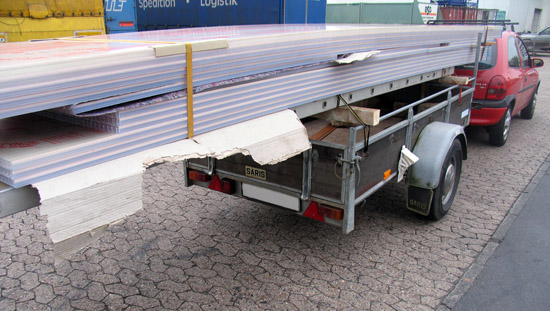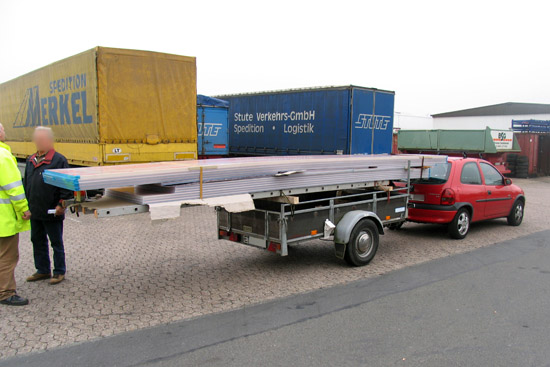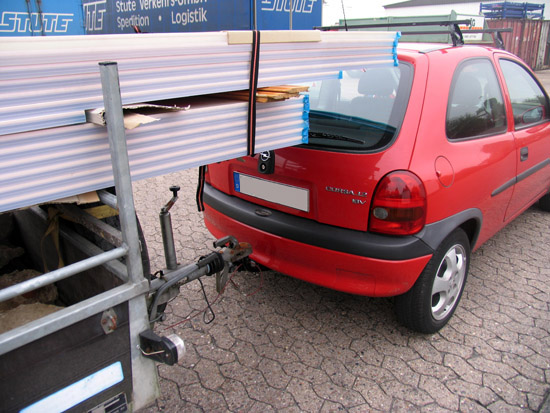| Photo of the month – June 2008 | [German version] |
Cry "havoc" and let slip the load for sure
There are times when truth is stranger than any fiction.
One of our fellow creatures with a considerable imaginative talent was faced with the problem of transporting a load of boards home – long boards at that. And even though it would appear that these boards were not rigid enough for the journey, our genius knew a way of solving the problem. He put his car’s trailer through a quick toughening-up regime to prepare it for the load.

Figure 1 [D. Wegner, Bremen Police Department]
The loading area was too small, and it wasn’t feasible to transport this load at an angle because it was too delicate – not to mention too long. And so it was necessary to construct an "artificial" loading area. Two pieces of squared lumber formed the basis. On top of these were placed two aluminum ladders. These ladders provided sufficient bending strength to allow the boards to be loaded on top of them. Magnificent!
The load securing methods used are also ingenious. The squared lumber was placed on top of the bars of the tailgate and end wall of the trailer. The ladders were "secured" to the trailer, otherwise the boards would have tipped off as soon as they were loaded. The boards themselves were srapped together with the ladders to form a bundle. At the front, the bottom package passed under one rail of the trailer and the top package rested on the rail. Because they were bundled together, this prevented the boards from tipping backwards. Which is an achievement that perhaps not everybody would have managed.

Figure 2 [D. Wegner, Bremen Police Department]
But…….!!!
| The ladders could act as sled runners on which the load is free to slip. | |
| The securing is worthless, because the load is free to move in all directions. | |
| The law allows the load to protrude "only" three meters beyond the end of the vehicle. Even this generous allowance appears to have been exceeded. | |
| When loaded like this, the boards generate a negative tongue load. This type of trailer and coupling, however, must always be subject to a positive tongue load. | |
| At the front, the load is only permitted to protrude beyond the front of the trailer as of a height of 2.50 m (above road level), and it is only permitted to protrude by a maximum of 0.50 m. |

Figure 3 [D. Wegner, Bremen Police Department]
Even under the slightest braking load, the load would have paid the driver a visit.
This load was extremely slippery, which did not make securing it any easier.
What is the proper way to transport something like this?
| With the right vehicle. | |
| For long loads like this, either a large trailer must be used or a vehicle with a sufficiently large loading area. | |
| The options for securing the load are important. Because the load appears to be extremely smooth, in other words, it has a very low coefficient of friction, direct lashings should be used. | |
The properties of the load must also be taken into account when deciding on the load securing method. With a load like this that is sensitive to pressure, measures must be taken to protect the load from the securing equipment and a method that puts less load on the goods should be selected. Tie-down lashings only function as a result of the friction generated by pressure on the load. In this example, there are two reasons why this method is unsuitable:
|
|
| Loop lashings solve this problem. |
Back to beginning
